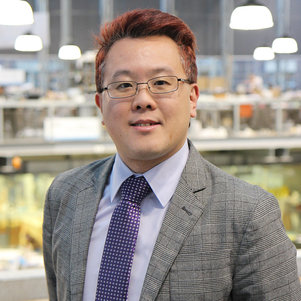The experts can’t do it alone
Smart construction leads to better buildings and better cities. At least, that is the intention. But this will only happen if we learn from mistakes and work together to find solutions, says professor of Design and Construction Management Paul Chan in his inaugural address. The experts can’t create the perfect future on their own.
Designers are always striving to create the perfect world, notes Chan. But what does that really mean, perfection? And more importantly, how can you achieve it? For one of his previous research projects, the new professor of Design and Construction Management asked a number of CEOs of construction companies about the major challenges of the future. What strategies had they developed to address climate change and circular construction, for example? The results were rather sobering. “They were trying, but the pressure of day-to-day business meant they sometimes couldn’t plan further than six months ahead,” explains Chan. “For the most part they were very pragmatic and concerned about the limitations they encounter in current practice.”
And that’s not as surprising as seems, he says. Because nobody knows what the future will look like. Who could have predicted 25 years ago that we would now be using our phones not only to make calls but also to film videos, find our way, send emails, pay for things, find dates and control building installations? “Was that consciously designed in this way by the planners? I doubt it,” says Chan. “I think it was more of a combination of what they imagined and what users told them.” Perhaps our buildings will undergo the same spectacular development as the smartphone. But construction CEOs will not be the ones to lead the way, because the average director knows more about operational management than about building innovation.
In other words, the road to perfection is strewn with imperfections, says Chan in his inaugural address entitled Constructing Futures: De-sign-ing boundaries of practice. The path we follow is unavoidably influenced by the obstacles and the boundaries we encounter along the way. “That’s why I say: embrace the imperfections. They help to show us the right path.”
The construction industry is evidently becoming increasingly aware of this. Contractors no longer build everything on their own; they are increasingly evolving into system integrators. This approach helps them to push back the boundaries they come up against. Bring the smartest players together to decide what the future should look like. Chan: “Who are the survivors? Those who are able to adapt. To do that, you have to look around you.”
Are we poisoning ourselves?
That thought can help to motivate students from Architecture and the Built Environment who are disappointed by reality after graduation. As students they hear how they are supposed to plan, design and budget construction projects, and how they should consider the lifecycle of a building in the process – one of the key objectives of the Design and Construction Management chair. When they get their first job in the real world, they soon find out that things are very different. But they really can use what they learned at university to help to change the direction, believes Chan.
Shouldn’t construction companies pay much more attention to what professors tell them? After all, they are the ones who can look years ahead? “Even professors don’t have all the answers,” reflects Chan. “Experts only know one piece of the puzzle. We will only be able to find a solution to today’s challenges, such as the sustainable transition that is required in the face of climate change, by interacting with other experts.”
Chan believes that science can help to develop future scenarios that may challenge existing building practice. Research can shed some light on whether we’re thinking in the right direction. For example, is airtight construction the right way to make homes more energy efficient, or will we end up poisoning ourselves because harmful gases cannot escape?
Smart technologies can act as beacons on the path towards a more perfect future, believes Chan. For example, computer simulations and smart algorithms help us visualise how we can create better neighbourhoods and build more energy-efficient buildings. And we can use sensor technology to monitor – and, if necessary, adjust – developed scenarios. We can even use 3D technology to develop completely new construction methods. Building structures are already rolling out of the concrete printer and 3D milling technology is being used to produce a pile of jigsaw pieces that together form a complete building. Wikihouse is a good example of this. “The technologies are already there, what’s lacking is the social and political will to apply them to the social context,” says Chan. “To achieve this, mutual relationships between academic disciplines and professional practice need to be intensified and communication with community stakeholders needs to improve".
In his role as coordinator of the project Stepping Out: Accelerating deep transdisciplinary and interprofessional learning for innovative actions, interventions and strategies of deep sustainable transitions in port area development, Paul Chan will spend the next few years investigating how the ‘learning professional’ can strengthen these ties.
Recently, the Dutch Research Council (NWO) announced that it would be awarding a grant to this project. Stepping Out investigates how professionals who are charged with designing the city of the future – architects, planners, civil servants and engineers – can step out of their comfort zone to come up with radical solutions for the transition to a sustainable city.
More information
On Friday 14 February, professor Design and Construction Management Paul Chan gives his inaugural address ‘Constructing futures: De-sign-ing boundaries of practice’. More information can be found here.

